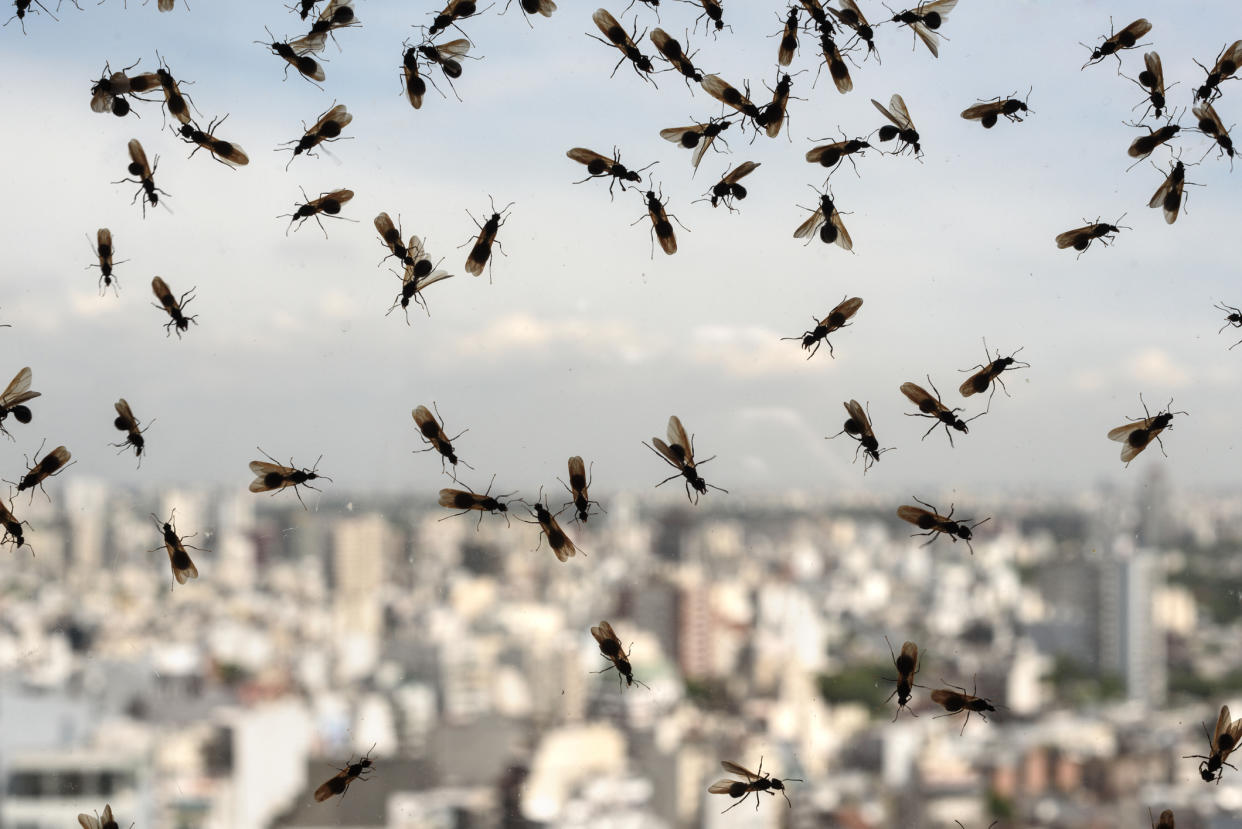Flying ant day: What is it, when is it and how to get rid of the pesky insects

Brits have been basking in the sunshine recently with the UK experiencing the hottest June on record this year.
This week has seen a fair few downpours, but with warmer temperatures set to return towards the end of the week, it could also mean the arrival of the dreaded flying ants.
We’ve got the lowdown on the unpredictable creatures and what 'Flying Ant Day', as it's widely known, is all about.
What are flying ants?
There are over 60 species of ant in the UK but the flying ants that we see swarming in the summer tend to be the sexually mature queens and males of the common black garden ant (also known as the Lasius Nige).
You can easily spot the queen ant, as they tend to be the largest and can grow up to 15mm long. Eek!
Read more: How hot does it have to be for schools and offices to close in a heatwave?, Yahoo Life UK, 5-min read
What is Flying Ant Day?
Flying Ant Day occurs when the queen ants are on the lookout for a new home but, unfortunately for us, they don’t leave the nest alone.
When the queens decide to up and flee, they bring the male ants along with them in order to mate en-route. This way, they can prepare to create a whole new colony elsewhere.
Large winged females and smaller winged males also join in on what is known as the ‘nuptial flight’ to mate.
In the run-up to the big day, worker ants spend weeks preparing to swarm by piling heaps of soil above their nests - another way to potentially spot a nest in your garden.
When is Flying Ant Day?
There isn’t actually a specific ‘Flying Ant Day’ (if there was, we’d certainly stay inside), but the insects tend to emerge from their nests in July or August.
Historically, stray flying ants are a warning sign that the colony’s getting set to relocate. However, one study conducted by the Society of Biology indicated more unpredictable swarming patterns during recent years, perhaps triggered by the change in climate.
Back in 2013 for instance, there was an entire flying ant month. Yikes!
Why is Flying Ant Day in the summer?
According to multiple sources, swarming is kick-started by the warm and humid weather hence the prevalence of flying ants in the summer.
Unfortunately for city-dwellers, they tend to prefer urban areas due to what is known as the ‘urban heat island effect’.
Where do flying ants come from?
If you’re hoping to prevent a swarm in your back garden, then you may need to check your patio for piles of soil ahead of the ‘nuptial flight’.
Flying ants tend to build nests in dry soil so can be found beneath flower beds, lawns and paving slabs.
Watch: 'Our homes have been invaded by swarms of flies - they crawl over us in our sleep'
How to get rid of flying ants
Although they’re not dangerous, flying ants can prove incredibly irritating. They’ve been known to bite or sting but this is fairly uncommon and they’re usually harmless.
If you find yourself faced with a swarm or nest in your garden, you can try the following methods for ridding yourself of them:
Pour boiling water into problem spots
Once you’ve identified where the nests may be in the garden (check patios, flower beds and beneath paving slabs) then pour boiling water into the area.
This should kill the bugs and hopefully prevent more from returning to the nest.
Use tin cans
One of the most talked about ways of deterring the swarm is to put tin cans atop their soil hills.
It’s crucial that you do this in the morning though, as the cans will heat up over the course of the day and this encourages ants to take their eggs into the tins.
In the afternoon, slide something beneath the cans and dispose of the eggs. This method certainly isn’t for the faint hearted.
Use ant powder
You can purchase ant powder or spray from Amazon and other retailers with prices starting from £3. Simply apply to any doorways, patios or floor areas where you have previously spotted the ants.
Most of the time, these products can also be used to prevent the likes of cockroaches, woodlice and other insects - making it a great investment for the home.
Shop: Zero In Ant Killer Powder | £5.99 from Amazon
Shop: Ant and Crawling Insect Killer Trigger Spray | £4.49 (Was £7) from Amazon
Use dishwasher liquid
If you’re on a budget, then dishwashing soap can prove just as useful. Simply pour some of the liquid into a spray bottle and mix with two cups with water.
Then, spray any stray ants with the homemade mixture.
Use sweetener
Artificial sweetener can prove deadly for the winged insects so mix one from home with apple juice to create a toxic paste. Then, pour the substance near to the nest.
Ants should carry it back to the colony which will result in more ants consuming the poisonous paste which will in turn, kill more of the population.

 Yahoo News
Yahoo News 

